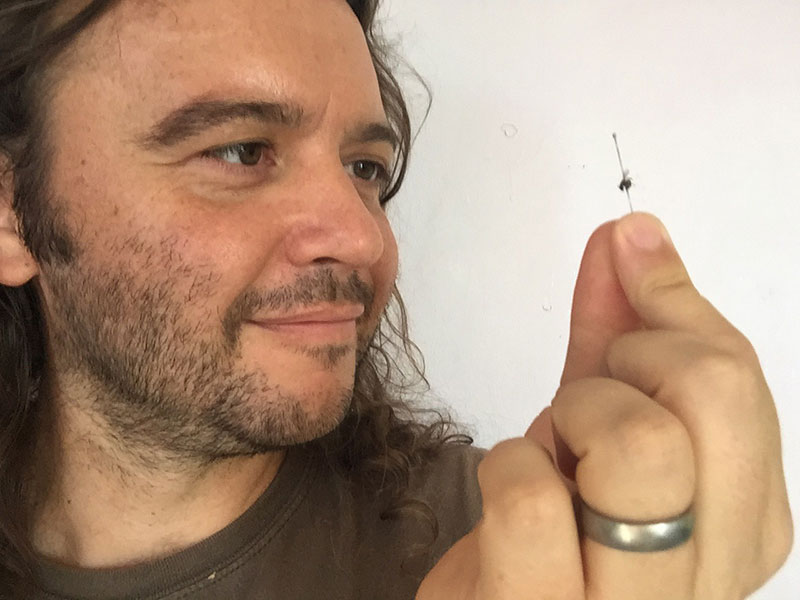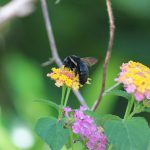The buzz about bees in the CNMI

James Herndon holding a tiny sweat bee from Saipan. Some bees in the CNMI are extremely small and therefore hard to study. The zoomed in microscope photos show this female sweat bee with pollen attached to her hairs. (CONTRIBUTED PHOTO)
We see them all around, in stripes of black and gold, buzzing from flower to flower. Yes, bees.
As tiny as they are, the significant role bees play in our lives are huge. Like birds and butterflies, bees are crucial pollinators, and crops they pollinate make up 35% of the global food production. Further, studies say that 75% of our food crops, and to some extent, nearly 90% of wild flowering plants depend on this pollination. So you see, bees more than just buzz around flowers, they help provide for our food. We need them.
Here in the CNMI, the most common types of bees are western honey bees, carpenter bees, and leafcutter bees. Saipan Tribune sat down with scientist James Herndon to talk more about these bees, their role, where we can find them, and how we can help them survive here on island.
Herndon, who is currently doing research on bees on island, has previously worked for the United States Department of Agriculture-Agricultural Research Service [USDA-ARS] Pollinating Insect Research Unit laboratory in Logan, Utah, for a research on bumble bee reproduction, bumble bee nest site preferences, and bumble bee husbandry for greenhouse pollination. He also worked on a native bee inventory of Carlsbad Caverns National Park in New Mexico and assisted with behavioral studies of tropical bees in Panama.
“There are many different types of animal pollinators in the CNMI including the fanihi, Micronesian honey-eaters, butterflies, and various types of wasps to name some. However, bees are special amongst other pollinators because they actively collect both pollen and nectar,” Herndon said.
“The fact that they collect both means they are transporting more pollen from flower to flower and increasing fertilization of some plants. Understanding the pollen preferences of both native and non-native CNMI bees may help increase populations of endangered native plant species and it may increase yields of cultivated plants also.”
According to Herndon, bee diversity in the CNMI and Guam ranges somewhere between 16 and 20 species, and that based on prior sampling, bee biodiversity and the number of endemic species is highest in the southern islands of Guam, Rota, Saipan, and Tinian with diversity and endemism getting lower in the Mariana islands north of Saipan.
Given how important bees are in our lives, and how, globally, they are increasingly under threat from our activities, we must do all that we can to help save bees.
Bee diversity
Many of the bees in the CNMI are introduced species, Herndon said, adding that the three most common types of bees seen here are western honey bees, carpenter bees, and leafcutter bees.
“The western honey bee… is the only bee species that lives in colonies and makes honey, wax, and propolis. This is also the only managed bee species in the CNMI by beekeepers… Carpenter bees are the large, shiny, black bees that are the loudest fliers. They excavate wooden tunnels in old trees and even in man-made wooden structures.”
Both bees were introduced into the CNMI from Hawaii, where they are also not native. Herndon said that carpenter bees are native to the Americas while western honey bees are native to Europe and Africa.
“The leaf cutter bees in the CNMI include multiple species most are introduced but some are native. The species you are most likely to see is the largest of the leaf-cutters found here, the non-native and widespread Megachile laticeps.”
Mostly black with some rusty red coloration on its head and thorax, Megachile laticeps carry pollen on its belly instead of on its legs like honey bees. For their nest, like many other leaf-cutter bees, they nest in pre-excavated cavities, cutting small half oval shaped leaf pieces from trees and carrying them back to the nest, and weaving them together to line and protect the offspring from moisture, mold, and harmful bacteria.
Herndon noted that as there is not a lot to share about the native species yet because their basic biology has not been studied, but said that some assumptions can be made about some of them because of the biology of species belonging to the same genus.
Some examples of some of the native species include Ceratina mariannens, which have only been documented in Saipan and Rota; Hylaeus rotensis, which are endemic to Rota; and Heriades paganensis, which are endemic to Pagan.
Herndon stressed that studying the potential of bees on island, even some non-native ones, can help diversify and increase food production in the CNMI.
“The large carpenter bees, while not native, could be a boon to foods grown here in the CNMI. Carpenter bees are one of the best pollinators of passion fruits and are able to pollinate plants like tomatoes and eggplants which honey bees do not pollinate.”
More research needed
“Bees are a very diverse group of insects with 20,000 species described and an estimated 10,000 more species yet to be discovered.”
Herndon hopes to establish a baseline study for native bees that would span an entire year, to get a good grasp on the bee populations of the CNMI, and to better understand their biology and the plants they interact with.
“Developing a baseline for what bee pathogens and parasites are currently on which islands would be helpful in understanding more about how to conserve the native bee species. What I have seen so far, from my personal insect collecting, are a lot of introduced species and very few native species.”
“We know next to nothing about the native species here so basically everything about them needs to be researched. A continual effort to sample bees throughout the year can provide information on when more adults are present or absent, how abundant species are, if they are endangered, and it may even lead to discovering new bee species.”
Having been particularly interested in finding Ceratina mariannensis, Herndon also stressed the need to investigate where native bees nest and the plants they forage on, among others.
“In Hawaii, the only native bees are the yellow-faced bees in genus Hylaeus. When researchers took the time to research them, they found that they pollinated many of the endangered plants of Hawaii but the bees were also deemed to be endangered as well after surveying the Hawaiian Hylaeus. This led to the first ever listing of any bee species by the U.S. Fish & Wildlife.”
“Researching the ecological effects of the non-native species is also important because non-native bees have been shown to outcompete and spread disease to native bees,” he added.
How can we help bees?
With so much help we get from bees, the least that we can do is try our very best to protect them.
“Refrain from using pesticides,” Herndon said. “There is a lot of evidence that pesticides wipe out bees and other beneficial insects.”
The USDA reports that the health and abundance of pollinators have declined in the recent decades due to a range of factors, which include pesticides, as exposure to these chemicals affects pollinator functions—reproduction or pollinator death.
Herndon also added that among the few things majority of us can do to help bees on island is to make sure to do what we can to promote more native flowering plants of the CNMI.
“Familiarize yourself with native plants and avoid removing them from your property,” he said. “Try to make sure to preserve potential bee habitat by not being too tidy with your landscaping. Many of the bees likely nest in stems, sticks, and rotting wood here. Maybe take a day off of landscaping and clearing brush to help the native bees out.”
“Recently someone researching Megachile laticeps found that papaya stems will attract these large leaf-cutter bees. If you’d like to observe them then feel free to put papaya stems out in a bundle attached to a tree and suspended off of the ground.”
So, if you want to have your own little experiment at home, Herndon suggested setting up “bee observation nests” by putting pithy stems in the ground perpendicularly or bundling them up and suspending them off of the ground. This way, you’re learning, enjoying, all while helping save bees.
Happy World Bee Day, CNMI!
- Western honey bee buzzing over flowers on Capitol Hill to collect and store honey. Native to Europe and Africa and introduced into the CNMI from Hawaii, western honey bees are one of the most commonly seen bee species on island along with carpenter bees and leafcutter bees. (IVA MAURIN)
- Non-native carpenter bee pollinating the extremely invasive Lantana shrub in Tinian. While non-native bees may pollinate crops that we eat they also contribute to propagating invasive species which can outcompete native plants. Further research on these introduced bees needs to be conducted to get the full picture of how they impact both our food supply and their surrounding environment. (CONTRIBUTED PHOTO)





























